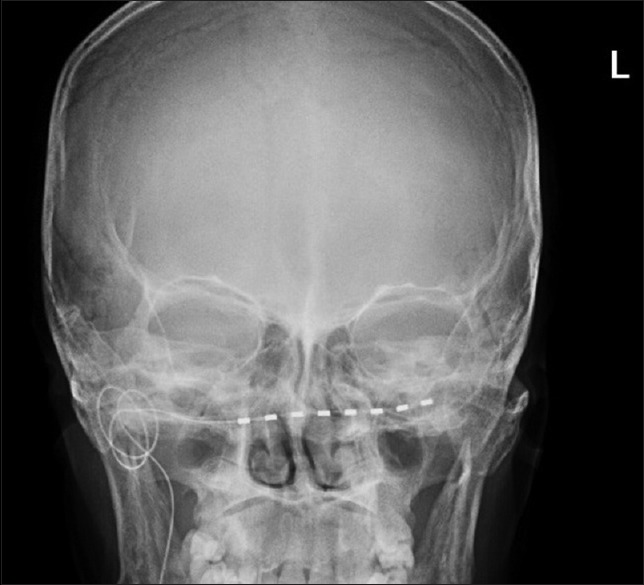To the Editor: Occipital neuralgia (ON) is the third most common headache syndrome following migraine and tension-type headache. In recent years, peripheral nerve stimulation (PNS) has been used to relieve severe pain caused by some types of neuralgia when conservative medical treatments and block procedures were not effective. PNS is a kind of neuromodulation using spinal cord stimulation device to relieve neuralgias. Here, we presented a case in which a patient with refractory ON was treated successfully with PNS.
A 59-year-old female patient presented with severe shooting pain at distribution of right occipital nerve 6 months ago. The diagnosis of right ON was established. Visual analog score (VAS) of this patient was 8–9. She has a history of right tympanitis and uncompleted hearing loss. The patient was medicated with acetaminophen, carbamazepine initially. The pain could not be relieved, and the medicines were changed to baclofen, lamotrigine, and pregabalin. This medical treatment had been used for 1 month, and the patient was still suffering from the severe pain. In addition, the pain gradually occurred at left side and became bilateral ON with VAS 9–10. Then, one percocet tablet was given every 8 h a day, and VAS was still 8–9. Bilateral occipital block procedures could relief the pain to VAS 2 but lasting not more than 24 h. The long-term pain negatively affected the patient's functionality, and the body weight of the patient was lost 20 kg within 6 months. The patient was referred to Neurosurgery Department of First Affiliated Hospital of Chinese People's Liberation Army General Hospital, and a PNS therapy was recommended. First, a trial implantation was performed. A 4 cm linear incision was made longitudinally under local anesthesia at right occipital area, 5 cm to the posterior edge of right ear. An 8-contact electrode (Medtronic 3778, Minneapolis, USA) was inserted percutaneously from lateral to medium, perpendicular to bilateral occipital nerve course at C1 vertebral level [Figure 1]. An external impulse generator (IPG) was connected to the electrode. The trial stimulation (3−, 5+, 7−; 3 V, 130 ms, and 60 Hz) successfully covered left occipital area, producing a significant pain relief (VAS from 9–10 to 2–4). After 7 days of trial stimulation, a permanent IPG (Medtronic Prime Advanced 37702, Minneapolis) was implanted subcutaneously at upper right chest. The patient was under followed up for 1-year reporting a long-lasting pain relief (usually without pain, occasionally transient VAS 3–4 pain) without any medication.
Figure 1.

Intraoperative X-ray image of bilateral occipital nerve stimulation lead.
The exact mechanisms of ON are still unknown recently, but some literature pointed out that whiplash injury, compression of C2 nerve, and compression of the upper cervical roots by arthritic changes in the spine are the leading possible causes.[1] The mechanisms of PNS for pain management are still under investigation; Bari and Pouratian demonstrated that some image changes could be found in many brain regions including the insula, cingulate cortex, prefrontal cortex, thalamus, and somatosensory regions when PNS working.[2] When considering overall PNS related complications, lead migration and infection are the two leading causes[3] and no other severe complications was reported until. Due to the high efficacy and low risk of occipital nerve stimulation, it could be used on some decrepit patients. Chaiban et al.[4] recently reported a successful treatment of an 86-year-old ON patient with a pacemaker. Besides ON, PNS was even used on patients with some severe headache syndromes, such as migraine, cluster headache, cervicogenic headache, and trigeminal neuralgia[5] when refractory to pharmatherapy and other noninvasive methods.
To the best of our knowledge, PNS for drug-resistant ON is not prevalent in China. The safety of PNS for a patient is an outstanding advantage deserving our recommendation.
Financial support and sponsorship
Nil.
Conflicts of interest
There are no conflicts of interest.
Footnotes
Edited by: Li-Shao Guo
REFERENCES
- 1.Sahai-Srivastava S, Zheng L. Occipital neuralgia with and without migraine: Difference in pain characteristics and risk factors. Headache. 2011;51:124–8. doi: 10.1111/j.1526-4610.2010.01788.x. [DOI] [PubMed] [Google Scholar]
- 2.Bari AA, Pouratian N. Brain imaging correlates of peripheral nerve stimulation. Surg Neurol Int. 2012;3(Suppl 4):S260–8. doi: 10.4103/2152-7806.103016. [DOI] [PMC free article] [PubMed] [Google Scholar]
- 3.Jasper JF, Hayek SM. Implanted occipital nerve stimulators. Pain Physician. 2008;11:187–200. [PubMed] [Google Scholar]
- 4.Chaiban G, Tolba R, Eissa H, Lirette LS, Almualim M, Malaty A, et al. Successful treatment of occipital neuralgia with implantable peripheral nerve stimulation in a pacemaker-dependent patient. Ochsner J. 2014;14:119–22. [PMC free article] [PubMed] [Google Scholar]
- 5.Hong J, Ball PA, Fanciullo GJ. Neurostimulation for neck pain and headache. Headache. 2014;54:430–44. doi: 10.1111/head.12292. [DOI] [PubMed] [Google Scholar]


